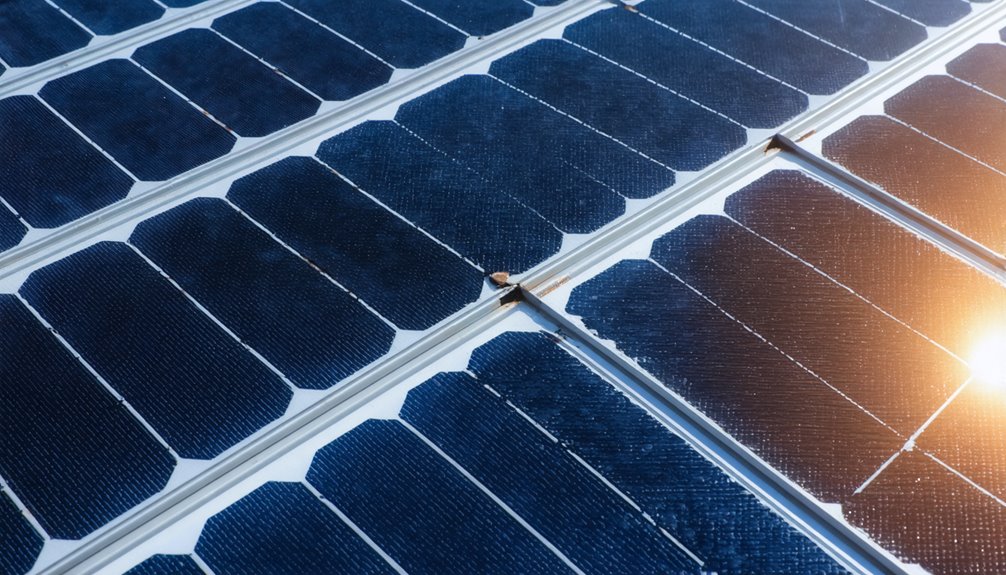You’re exploring solar panels, and efficiency differences can make or break your energy output. Monocrystalline silicon tops the charts, but polycrystalline and thin-film options vary widely in performance. Emerging materials like perovskites promise even more. Which factors tip the scales for your setup?
Key Takeaways
- Monocrystalline silicon panels achieve 18-24% efficiency due to high-purity silicon and advanced designs.
- Polycrystalline silicon panels offer 13-16% efficiency, being more affordable but less effective in heat.
- Thin-film panels range from 10-20% efficiency, excelling in flexibility and high-temperature performance.
- Perovskite materials reach up to 27% lab efficiency, with potential for hybrids at 40%, but face stability issues.
- Overall, monocrystalline leads in efficiency, while thin-film performs better in heat despite lower rates.
Monocrystalline Silicon Efficiency

Monocrystalline silicon solar panels deliver top-tier efficiency, typically ranging from 18% to 24%, making them ideal for residential setups where space and performance matter.
You’ll appreciate how they’re crafted from high-purity silicon, which boosts electron movement and converts sunlight into electricity more effectively than other types.
You choose these panels for their rounded design that packs cells densely, so you need less space to generate the same power.
As a savvy buyer, you’ll find that partnering with a reliable solar panel supplier guarantees access to advanced options like N-type cells, pushing efficiencies beyond 24%.
You’ll invest confidently knowing these panels last over 30 years with just 0.5% annual degradation, offering durable, high-performance solar energy for your home.
Polycrystalline Silicon Efficiency
You’ll opt for polycrystalline silicon solar panels if budget matters, as they deliver efficiencies from 13% to 16%—slightly lower than monocrystalline types but still reliable for residential use.
You produce these panels by melting silicon and forming it into square crystals, which creates less waste during manufacturing than monocrystalline methods. This simpler process makes them more affordable, so you’ll appeal to cost-conscious choices without sacrificing much.
You should note that polycrystalline panels’ performance drops in high-temperature conditions, so consider this if you live in warmer climates.
Despite the lower efficiency, you’ll get decent output and a long lifespan from them, making them a solid pick for home solar systems where value trumps peak performance.
Thin-Film Material Efficiency
Thin-film solar panels offer efficiencies from 10% to 20%, trailing crystalline silicon types but excelling in flexibility and lightweight design.
You’ll appreciate how you can bend and install them on curved surfaces or portable devices, where rigid panels won’t work. They also weigh less, so you save on structural support costs.
You should consider cadmium telluride (CdTe) options, as they reach up to 17.3% efficiency and dominate the thin-film market commercially.
They’re your go-to for cost-effective, large-scale setups.
If you need something for small gadgets, amorphous silicon (a-Si) cells deliver 5.9% to 13.8% efficiency.
You won’t get massive power output, but they’re ideal for calculators or wearables.
Don’t overlook thin-films’ perks: you get better performance in hot climates and use fewer materials, slashing production expenses.
Perovskite and Emerging Materials
As you shift to cutting-edge options, perovskite solar cells stand out with lab efficiencies reaching up to 27%, potentially outpacing traditional silicon tech. You’ll find these cells use materials with a crystal structure mimicking the mineral perovskite, enabling flexible and lightweight designs that fit diverse applications.
You appreciate how perovskites cost less to produce than silicon, making solar energy more affordable overall. Researchers push boundaries with hybrid silicon-perovskite tandem cells, targeting efficiencies near 40% by combining material strengths.
Yet, you note challenges like limited stability and longevity, though new encapsulation methods boost durability for real-world use.
| Aspect | Perovskite Insight |
|---|---|
| Efficiency Potential | Up to 27% in labs, hybrids to 40% |
| Production Cost | Cheaper than silicon, lowers prices |
| Design Advantages | Flexible, lightweight structures |
| Durability Improvements | Encapsulation enhances stability |
Comparative Efficiency Factors

While perovskites push efficiency boundaries, you compare solar materials by examining how monocrystalline, polycrystalline, and thin-film options stack up in performance.
You’ll find monocrystalline panels lead with 15% to over 24% efficiency, thanks to pure silicon that boosts photon absorption and cuts energy loss. They excel in low-light conditions, making them ideal for varied environments.
In contrast, polycrystalline panels hit 13-16% efficiency; they’re made from melted silicon crystals, which hampers performance in low light and high temperatures, leading to greater degradation.
Thin-film panels lag at 7-13% efficiency, using materials like cadmium telluride or amorphous silicon in thin layers. However, they handle high temperatures with less degradation, offering advantages in hot climates.
External factors like temperature and light exposure greatly influence these efficiencies, so you weigh conditions when choosing.
Conclusion
When you’re picking solar panels, consider your space, budget, and climate. You’ll get top efficiency from monocrystalline silicon at 18-24%, but perovskites promise over 27% if stability improves. Polycrystalline offers affordable 13-16%, while thin-film suits hot areas at 10-20%. Don’t overlook factors like temperature and longevity—they’ll affect your energy output and ROI. Choose wisely; you’ll harness the sun more effectively!


